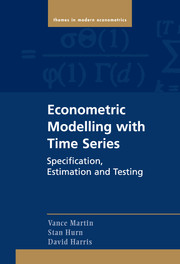Book contents
- Frontmatter
- Contents
- List of Illustrations
- Computer Code Used in the Examples
- Preface
- PART ONE Maximum Likelihood
- PART TWO Regression Models
- 5 Linear Regression Models
- 6 Nonlinear Regression Models
- 7 Autocorrelated Regression Models
- 8 Heteroskedastic Regression Models
- PART THREE Other Estimation Methods
- PART FOUR Stationary Time Series
- PART FIVE Nonstationary Time Series
- PART SIX Nonlinear Time Series
- Appendix A Change of Variable in Density Functions
- Appendix B The Lag Operator
- Appendix C FIML Estimation of a Structural Model
- Appendix D Additional Nonparametric Results
- References
- Author Index
- Subject Index
6 - Nonlinear Regression Models
from PART TWO - Regression Models
Published online by Cambridge University Press: 05 January 2013
- Frontmatter
- Contents
- List of Illustrations
- Computer Code Used in the Examples
- Preface
- PART ONE Maximum Likelihood
- PART TWO Regression Models
- 5 Linear Regression Models
- 6 Nonlinear Regression Models
- 7 Autocorrelated Regression Models
- 8 Heteroskedastic Regression Models
- PART THREE Other Estimation Methods
- PART FOUR Stationary Time Series
- PART FIVE Nonstationary Time Series
- PART SIX Nonlinear Time Series
- Appendix A Change of Variable in Density Functions
- Appendix B The Lag Operator
- Appendix C FIML Estimation of a Structural Model
- Appendix D Additional Nonparametric Results
- References
- Author Index
- Subject Index
Summary
Introduction
The class of linear regression models with normal disturbances discussed in Chapter 5 is now extended to allow for nonlinearities. Three types of extensions are investigated. The first is where the exogenous variable xt is specified as a nonlinear function. The second is where the dependent variable yt is specified as a nonlinear function. The third is where the disturbance term ut is specified to have a non-normal distribution. Nonlinear specifications of time series models are discussed in Part SIX where nonlinearities in the conditional mean are investigated in Chapter 19, nonlinearities in the conditional variance are discussed in Chapter 20 and nonlinearities arising from models where the dependent variable is a discrete random variable are discussed in Chapter 21.
As with the treatment of linear regression models in the previous chapter, nonlinear regression models are examined within the maximum likelihood frame work. Establishing this link ensures that methods typically used to estimate nonlinear regression models, including Gauss-Newton, nonlinear least squares and robust estimators, immediately inherit the same asymptotic properties as the maximum likelihood estimator. Moreover, it is also shown that many of the statistics used to test nonlinear regression models are special cases of the LR, Wald or LM tests discussed in Chapter 4. An important example of this property is a non-nested test used to discriminate between models that is based on a variation of a LR test.
- Type
- Chapter
- Information
- Econometric Modelling with Time SeriesSpecification, Estimation and Testing, pp. 194 - 227Publisher: Cambridge University PressPrint publication year: 2012



